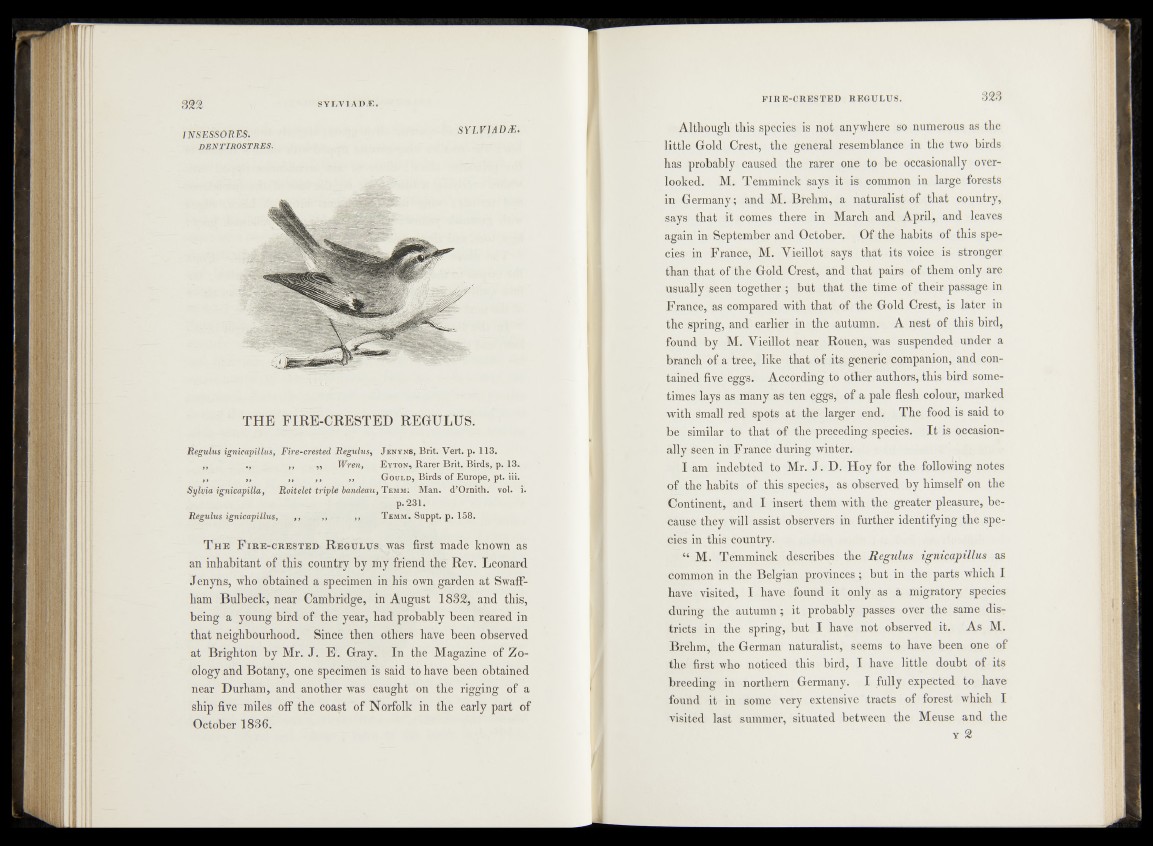
1NSESS0RES. SYLV1ADÆ.
DEN T I ROST RES.
T H E F IR E -C R E ST ED REGULUS.
Regulus ignicapillus, Fire-crested Regulus, J enyns, Brit. Yert. p. 113.
„ ., ,, ,, Wren, E yton, Rarer Brit. Birds, p. 13.
,, ,, ,, , , ,, G ould, Birds of Europe, pt. iii.
Sylvia ignicapilla, Roitelet triple bandeau, T emm: Man. d’Ornith. vol. i.
p.231.
Regulus ignicapillus, „ ,, ,, T em m . Suppt, p. 158.
T h e F i r e - c r e s t e d R e g u l u s was first made known as
an inhabitant of this country by my friend the Rev. Leonard
Jenyns, who obtained a specimen in his own garden at SwafF-
ham Bulbeck, near Cambridge, in August 1882, and this,
being a young bird of the year, had probably been reared in
that neighbourhood. Since then others have been observed
at Brighton by Mr. J. E. Gray. In the Magazine of Zoology
and Botany, one specimen is said to have been obtained
near Durham, and another was caught on the rigging of a
ship five miles off the coast of Norfolk in the early part of
October 1836.
Although this species is not anywhere so numerous as the
little Gold Crest, the general resemblance in the two birds
has probably caused the rarer one to be occasionally overlooked.
M. Temminck says it is common in large forests
in Germany; and M. Brehm, a naturalist of that country,
says that it comes there in March and April, and leaves
again in September and October. Of the habits of this species
in France, M. Vieillol says that its voice is stronger
than that of the Gold Crest, and that pairs of them only are
usually seen together ; but that the time of their passage in
France, as compared with that of the Gold Crest, is later in
the spring, and earlier in the autumn. A nest of this bird,
found by M. Vieillot near Rouen, was suspended under a
branch of a tree, like that of its generic companion, and contained
five eggs. According to other authors, this bird sometimes
lays as many as ten eggs, of a pale flesh colour, marked
with small red spots at the larger end. The food is said to
be similar to that of the preceding species. It is occasionally
seen in France during winter.
I am indebted to Mr. J. D. Hoy for the following notes
of the habits of this species, as observed by himself on the
Continent, and I insert them with the greater pleasure, because
they will assist observers in further identifying the species
in this country.
“ M. Temminck describes the Regulus ignicapillus as
common in the Belgian provinces; but in the parts which I
have visited, I have found it only as a migratory species
during the autumn; it probably passes over the same districts
in the spring, but I have not observed it. As M.
Brehm, the German naturalist, seems to have been one of
the first who noticed this bird, I have little doubt of its
breeding in northern Germany. I fully expected to have
found it in some very extensive tracts of forest which I
visited last summer, situated between the Meuse and the
y 2